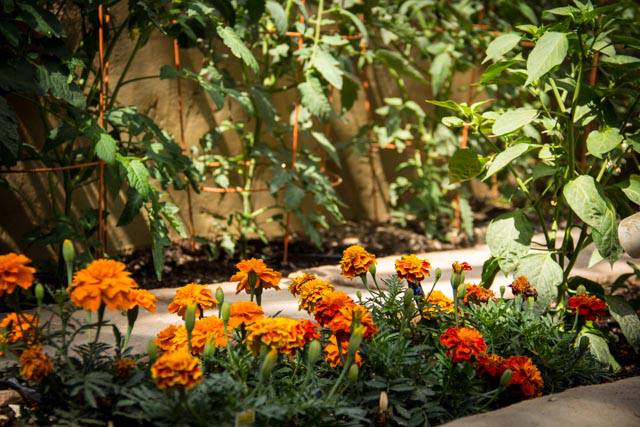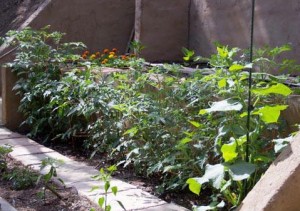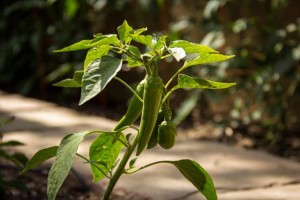My husband Adam and I have an organic vegetable and herb garden to provide for our organic nutrition.
Prior to this I have never done any gardening, so I really didn’t know what I was doing and I was a bit nervous. I read Mel Bartholomew’s Square Foot Gardening and learned how to grow an efficient garden. (One requiring less maintenance than traditional gardens.) We bought enough organic plant compost to fill our garden beds 9-12 inches deep, which left plenty of room for the plant roots. Compost is decomposed organic matter, which enriches or “feeds” the soil. We are also composting our plant food waste instead of throwing it away. By next year we plan to use our own composted material for our garden, instead of purchasing it.
In addition to the plant compost, you will also require a few of the following basic items, some of which you may have at home: Waterproof gloves, a trowel, a spade and a water bucket.
A common or traditional way of gardening is to sprinkle seeds down a long row. With this method, the crops end up very close together and need to be thinned out and transplanted. While it is simple to sprinkle seeds down a row, in the final analysis, square foot gardening requires less work and maintenance and yields a considerably better harvest.
Square foot gardening is based on 12 inch x 12inch squares instead of rows to maximize garden space while keeping the maintenance to a minimum. I placed square stones down next to the garden squares so that I will never need to walk or kneel on the soil. This way, my soil will say fluffy and loose to allow water and air to penetrate to the plant’s root.
From the very beginning, I spaced the plants according to how big they grow and how far apart they should be planted in order to develop properly. This method saves me the time it takes for unnecessary watering, thinning and transplanting. Instead of doing this in a row, which usually leaves too much unused space between rows, the plants are spaced the same distance apart in all directions within the 12-inch X 12 inch square.
For example, 1 pepper is planted in the middle of 1 square foot because it needs 12 inches of space around it, and 9 spinach plants can be spread out evenly in 1 square foot because they need 4 inches of space around them.
Adam and I love to grill vegetables, make salads, sauces, salsas, and vegetable juices, so we decided to grow the veggies and herbs we enjoy eating. This has made it so exciting because there is nothing like growing and eating your very own food! We can make certain it is grown organically (no pesticides, etc.), we get to plant it and watch it grow, and when we harvest them, we get to enjoy them at their freshest state…. right after being picked!
We planted tomatoes, peppers, and cucumbers first. I am shocked at how fast the tomatoes and cucumbers grow! You can literally sit and watch them get larger! They grew about 4-5 feet in one month. I am fascinated at HOW they grow as well. We are training them to grow vertically (using poles and wiring) to save space. Otherwise, they would grow horizontally, taking up a lot of garden space. The cucumbers start with a beautiful little yellow flower and the tomato plant smells so good, I love to smell the leaves!
In an attempt to feed our plants more nutrients on a monthly basis, we recently added fertilizer to the crops that were planted a month ago. Unfortunately, we found out the next day that raccoons liked something about that fertilizer. These nocturnal animals, came out that night, made their way into our garden and made a big mess in the soil. We are currently looking into methods of keeping them out.
We recently planted some cilantro, parsley, basil, beets, rainbow Swiss chard, arugula and eggplants. I need to keep the soil wet daily for two weeks while they adjust to the shock of their new home and then I will change to watering them heavily twice a week. Watering them twice a week will make their roots stronger and deeper as they will try to find water in the earth on the days they don’t get water.
I would like to share with you the importance of what you wear while you garden because if you are anything like me, you would be WAY off! My first day gardening I wore all black because I knew I was going to get pretty dirty. I almost overheated that day. Black makes it so much hotter! It’s best to wear clothes light in weight and light in color. Wear something that will cover your knees if you need to kneel and don’t forget to wear a hat to keep your head cool and to keep your face and neck out of the sun. Waterproof gloves are important. Your hands get wet from planting because you are adding water and getting your hands in the soil. Even though you can use a trowel or a fork, it’s usually easier to just use your hands to dig a hole for small plants. Once you dig the hole, you add water to the hole to make sure the soil is very moist and then use your hands to place the plant in and add the soil all around it. You will need to add more water again at the end.
Overall, it is an extremely organic experience to spend time in the garden caring for the wonderful things our earth has to offer. I have developed a love for gardening and I look forward to spending time in our garden, caring for the plants. I find it is therapeutic and gives me a sense of nurturing. I also enjoy spending this time outdoors in nature with my husband. It brings us both happiness and fulfillment to work outside in our yard and invest our time to grow food that we will enjoy together and share with our family and friends. This week, we picked our first cucumber, sliced it up, and enjoyed its freshness. I don’t think I have ever enjoyed a cucumber so much!
Thanks for reading. —



